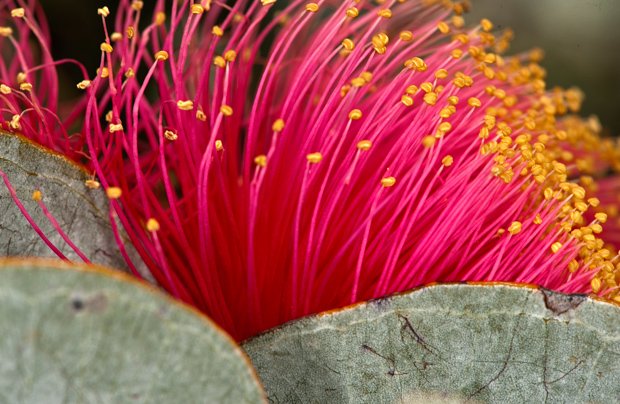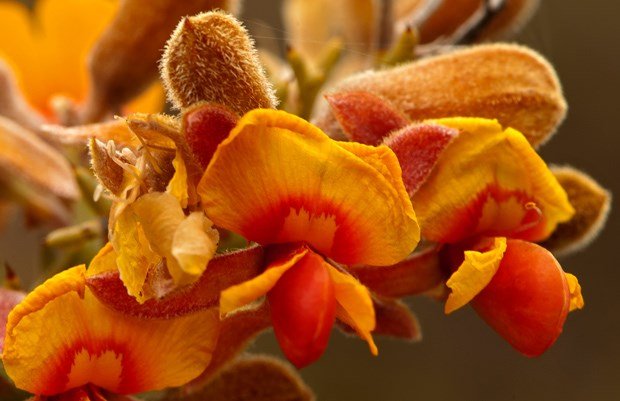Gallery: Wildflowers found in Western Australia

Mottlecah (Eucalyptus macrocarp) flower in spectacular fashion, bursting from a large pod, splitting it slowly in half to produce flowers up to 10cm in diameter, usually bright red or pink-red. The species name is derived from the Greek words, makros, meaning large and karpos, meaning fruit.

The flower (shown here) of slow-growing grass trees (some examples of which are among the oldest living plant species in the world) are sometimes used as a bushy’s compass because their flowers open most on the sunnier, northern side. Their stems also made good fishing spears and the waterproof resin, taken from the leaves near the trunk, has a multitude of uses.

Rocky outcrops are often havens for native species in farming areas around Kalbarri NP, where this picture was taken. Widespread agricultural clearing has occurred around the park.

The bulbous flowering head of the kingia (Kingia australis) sprout after fire, their growth likely triggered by the release of ethylene gas, according to Dr Kinglsey Dixon, the director of science at Kings Park and Botanic Garden in Perth. Endemic to south-west Western Australia, this slow-growing, silvery-leaved plant has a thick, often blackened trunk that reaches 4-8m tall.

The sparkling globules on a sundew (Droseraceae sp.) are not actually morning dew condensation, but sticky nectar used by the insect-catching plants to tempt unsuspecting prey. Any invertebrate unlucky enough to be caught is then ingested by the pretty carnivores.

Explorer William Dampier collected the first Australian daisy, a Brachyscome, in 1699 from Shark Bay in Western Australia. Many Australian daisies were introduced into Europe prior to the mid-19th century and were very popular in the colony from the 1860s until the turn of the century.

You’re unlikely to see these charming woolly pink pixie mop flowers (Petrophile linearis) in the eastern states, where they’re particularly hard to grow. These picture-pretty florals, whose delicate red and orange anthers dangle in anticipation of releasing pollen, are endemic to WA’s south-west where they occur naturally in sandy soils.

The red ‘lip’ of a king spider orchid (Caladenia pectinata) attracts wasps who, thinking that it’s a mate, rub against it and take away pollen to fertilise another flower.

The woolly, wispy heads of grey and blue smoke-bush flowers (Conospermum sp.) sway in the wind like clouds of smoke.

Stark white spider orchids (Caladenia longicauda eminens) flower between September and October, often heavily after summer bushfires, and usually in the heavier soils on rises around coastal saltlakes.

Wildflower guide Mike Newton walks botany enthusiasts through some of the 850 flowering species found in biodiversity-rich Lesueur National Park – 250 flora species here can be found nowhere else.

The donkey orchid (Orchidaceae diuris) is a perennial flower native to Australia, with the exception of one species found in Timor. Two large petals stick up towards the top of the flower giving it a donkey-esque appearance.

After his 1699 expedition William Dampier was among the first to cast aside the idea that WA’s low, scraggly looking vegetation was of little botanical worth and commented on the predominance of blue flowers.

Mass flowerings of yellow leschenaultia (Lechenaultia linarioides) can be found in spring. It’s cream and red flowers are seen hanging off a short, tangled 1m-high shrub.

Pincushion cone flowers (Isopogon dubious) are spectacular shrubs, whose species name arose from doubt about its generic classification when the flower was originally recorded.

Photographer Don Fuchs gets up close and personal with the pretty floral heads of orchids (see issue 110, out in September, for our story photographed by Esther Beaton on orchids and wasps).

It’s common name is derived from the family’s long tapered petals. Caladenia is also one of the largest orchid genera in Australia. The family name, derived from Greek, means beautiful glands – referring to the ornate ‘lip’ of the flower.

Of the flowers in the flame pea genus (Chorizema sp.) all but one is endemic to WA. They tend to fair better in low-humidity environments.

Fringe lilies (Thysanotus multiflorus) feature three petals that are fringed by a delicate collection of hairs.

The banksia genus is named after Sir Joseph Banks who collected the first specimens in NSW in 1770. These flowers show strong adaptions to fire, the woody fruit of many species opening to shed seeds only after a fire.

The wildflowers of WA are inventive survivors forced to diversity in order to try to survive in the west’s sandy, loamy soils. As a result WA’s wildflower endemism is second only to perhaps South Africa’s in the world of botanical riches.

Home Topics Science & Environment Gallery: Wildflowers found in Western Australia


